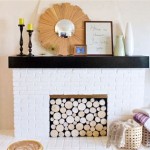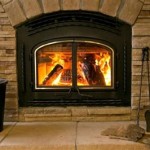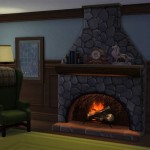How to Redo a Fireplace with Stacked Stone
Redoing a fireplace can dramatically transform the aesthetic of a living space. One popular method for achieving a modern and visually appealing upgrade is the application of stacked stone veneer. This process involves covering the existing fireplace structure with thin, lightweight stone pieces, creating the illusion of a natural stone fireplace without the associated weight and structural requirements of real stone. This article provides a comprehensive guide on how to redo a fireplace with stacked stone, covering preparation, installation, and finishing.
Before embarking on this project, it's crucial to assess the existing fireplace structure. Examine the surface for any damage, such as cracks, loose brickwork, or uneven areas. Addressing these issues before applying the stone veneer is paramount for a stable and long-lasting result. Consider the overall design and desired aesthetic. Stacked stone comes in various colors, textures, and sizes, so selecting the right style to complement the room's décor is essential. Also, ensure compliance with local building codes and regulations regarding fireplace renovations.
Preparation is Key
Proper preparation is the foundation for a successful stacked stone fireplace remodel. This stage involves cleaning, repairing, and preparing the existing surface to ensure optimal adhesion of the stone veneer. Neglecting this step can lead to premature failure of the installation.
Begin by thoroughly cleaning the existing fireplace surface. Remove any dust, dirt, soot, or debris with a wire brush and a solution of water and mild detergent. Rinse the surface thoroughly with clean water and allow it to dry completely. If the fireplace is painted or has a glossy finish, it may be necessary to roughen the surface with sandpaper to provide better adhesion for the mortar.
Inspect the surface for any cracks or damage. Small cracks can be filled with a patching compound designed for masonry. Larger cracks or damaged brickwork may require more extensive repairs, such as replacing damaged bricks or applying a concrete resurfacer. Ensure that any repairs are fully cured and dry before proceeding with the installation. For particularly uneven surfaces, consider applying a thin coat of mortar or self-leveling compound to create a smooth and even base for the stone veneer.
Apply a layer of metal lath to the prepared surface. Metal lath provides a mechanical bond for the mortar, significantly improving the adhesion of the stone veneer. Secure the metal lath to the fireplace structure using masonry screws or nails, ensuring that it is firmly attached and covers the entire area to be clad with stone. Overlap the edges of the metal lath by at least one inch to create a continuous and reinforced surface.
Apply a scratch coat of mortar over the metal lath. The scratch coat is a thin layer of mortar that provides a bonding surface for the stone veneer. Use a notched trowel to apply the mortar evenly, creating ridges that will enhance the mechanical bond. Allow the scratch coat to dry for at least 24 hours, or according to the manufacturer's instructions, before proceeding with the stone veneer installation. The scratch coat should be firm but not completely hardened, allowing the stone veneer to adhere properly.
Installing the Stacked Stone Veneer
The installation of the stacked stone veneer is a meticulous process that requires careful attention to detail. Proper alignment, spacing, and mortar application are crucial for achieving a professional and visually appealing result. Adhering to the manufacturer's guidelines for mortar mixing and application is also essential.
Begin by dry-fitting the stone veneer pieces. This involves arranging the stones on the floor or a flat surface to determine the desired pattern and layout. Dry-fitting allows you to visualize the final appearance and make any necessary adjustments before applying the mortar. Consider the color variations and textures of the stones to create a balanced and aesthetically pleasing design.
Mix the mortar according to the manufacturer's instructions. Use a mixing drill and a mixing paddle to ensure that the mortar is thoroughly combined and has a consistent consistency. Avoid adding too much water, as this can weaken the mortar and compromise its bonding strength. The mortar should be thick enough to hold its shape but pliable enough to be easily applied.
Apply a layer of mortar to the back of each stone veneer piece. Use a notched trowel to create ridges in the mortar, ensuring that the entire back surface is covered. The amount of mortar required will depend on the size and weight of the stone, as well as the texture of the scratch coat. As a general rule, apply enough mortar to ensure a strong bond but avoid applying too much, which can cause it to squeeze out between the stones.
Press the stone veneer piece firmly onto the scratch coat, wiggling it slightly to ensure good contact and adhesion. Start at the bottom of the fireplace and work your way upwards, maintaining consistent spacing between the stones. Use spacers or shims to create uniform joints, typically ranging from 1/4 inch to 1/2 inch. Remove any excess mortar that squeezes out between the stones with a small trowel or putty knife. Clean the face of the stones with a damp sponge to remove any mortar residue.
Continue installing the stone veneer pieces, working in small sections at a time. Check the alignment and level of the stones frequently, using a level or straightedge to ensure that they are properly positioned. If necessary, use a rubber mallet to gently tap the stones into place. Pay particular attention to corners and edges, ensuring that the stones are properly trimmed and fitted to create a clean and professional finish. Consider using a wet saw with a diamond blade to cut the stones to the desired size and shape.
Finishing Touches and Maintenance
Once the stone veneer has been installed, the final step is to apply the finishing touches and establish a maintenance routine. These procedures will enhance the overall appearance and longevity of the stacked stone fireplace, ensuring it remains a focal point of the room for years to come.
Allow the mortar to cure completely according to the manufacturer's instructions, typically 24 to 72 hours. During this time, avoid disturbing the stone veneer or exposing it to excessive moisture. Once the mortar is cured, inspect the joints for any gaps or voids. Fill any imperfections with mortar using a grout bag or a pointing trowel. Smooth the mortar joints with a damp sponge or a jointing tool to create a uniform and professional appearance.
Apply a sealant to the finished stone veneer. Sealing the stone will protect it from moisture, stains, and discoloration. Choose a sealant that is specifically designed for natural stone or stone veneer and follow the manufacturer's instructions for application. Apply the sealant evenly using a brush, roller, or sprayer, ensuring that all surfaces are thoroughly coated. Allow the sealant to dry completely before using the fireplace.
Regularly clean the stacked stone fireplace to remove dust, dirt, and soot. Use a soft brush or a vacuum cleaner with a brush attachment to remove loose debris. For more stubborn stains, use a mild detergent and water solution, gently scrubbing the affected area with a soft cloth or sponge. Avoid using harsh chemicals or abrasive cleaners, as these can damage the stone veneer. Rinse the surface thoroughly with clean water and allow it to dry completely.
Inspect the stone veneer periodically for any signs of damage, such as cracks, loose stones, or mortar deterioration. Address any issues promptly to prevent further damage. Repair any cracks with a patching compound designed for masonry. Reattach any loose stones with mortar, following the same installation procedures as described above. Reapply sealant as needed to maintain the protective barrier. Consider consulting with a professional contractor for more extensive repairs or maintenance.

Stone Fireplace Design And Remodel

12 Stacked Stone Fireplace Ideas For Optimal Coziness

Pin On Fireplace Makeover

Stone Fireplace Design And Remodel

Hirondelle Rustique Diy Stacked Stone Fireplace First Remodeling Project Part 2 Fireplaces Brick Makeover Remodel

Stacked Stone Fireplace How To Diy

Airstone Stacked Stone Fireplace Update The Kim Six Fix

Diy Fireplace Makeover With Stacked Stone

How To Update Your Fireplace With Stone Evolution Of Style

Thin Stone Veneers Make A Fireplace Update Easy Swenson Granite 100 Natural Stones
Related Posts








